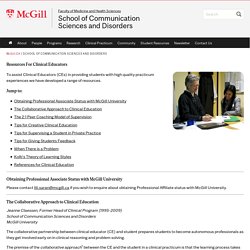

Lyndsey Cole
How to Mind Map with Tony Buzan. Take 5: One Minute Preceptor. Guide to Clinical Supervision p. 37 42. School of Communication Sciences and Disorders. To assist Clinical Educators (CEs) in providing students with high quality practicum experiences we have developed a range of resources.

Jump to: Obtaining Professional Associate Status with McGill University Please contact lili.saran@mcgill.ca if you wish to enquire about obtaining Professional Affiliate status with McGill University. The Collaborative Approach to Clinical Education Jeanne Claessen, Former Head of Clinical Program (1995-2009) School of Communication Sciences and Disorders McGill University The collaborative partnership between clinical educator (CE) and student prepares students to become autonomous professionals as they get involved early on in clinical reasoning and problem solving. The premise of the collaborative approach1 between the CE and the student in a clinical practicum is that the learning process takes place on a continuum consisting of three main stages, each with its distinct characteristics. Strategies for Clinical Teaching Joanne E. Schupbach Practice Management and Professional Issues Professional Issues 6944.
Editor's note: This text-based course is a written transcript of the live seminar, "Strategies for Clinical Teaching," presented by Joanne Schupbach, M.S., M.A., Manager Audiology Clinical Education, Assistant Professor, Rush University Medical Center.

The course handout is available here (PDF) - it is recommended to download the course handout prior to reading the text course. In my role here at the university, my interests have focused on clinical education including clinical teaching, supervision and mentorship. Today I would like to share some information with you regarding what makes a positive learning environment and specific strategies that can be used in clinical teaching. Rush University is a multidisciplinary health care institution. Much of what I have learned about clinical teaching has come from evidence in other areas of health care including nursing, physical therapy, occupational therapy, and medicine. Clinical Teaching Goals This is quite a mandate for all of us. Goals from Class 3 23. What are SMART Goals? Tihen. Broyles student2. Broyles supervisor2. Broyles student1. Broyles supervisor1. Larson Student. Larson Supervisor. Casey supervision self assessment.
McCrea, p. 62 65. McCrea, p. 59 61. McCrea, p. 55 58. McCrea, p. 51 53. McCrea, p. 47 49. Guide to Clinical Supervision Chapter 3. Guide to Clinical Supervision p. 28.
Customized to my hospital placement: 1. Being flexible: you have to respond to unexpected situations with your patients. For example, if you planned to complete a bedside swallow assessment but your patient was on a high dose of medication and not fully alert, it is best to wait to complete it at another time. 2. Identifying and resolving conflict: Make sure you and your patient's nurse are on the same page about the patient's diet plan. 3. Using decision making to lead: Take into consideration what the patient and their family wants before making a decision. 4. Developing positive relationships: It is important to establish a good relationship so that communication between each other will be good. I have been able to be honest with what I am confident/comfortable doing with my supervisor. 5. Practice persistence: I am learning new medical terms so I am always reviewing definitions and taking notes. 6. Demonstrating intellectual curiosity: I am completing swallow trainings outside of my hospital placement so that I can become more confident with reviewing an MBSS. 7. Practicing sensitivity and respect: I always make sure to treat nurses, doctors, and patients with respect and try to be sensitive to every patient's situation and to not judge anything. 8. Reflecting and self-assessing: making sure I am trying to master every medical setting goal I have made for myself so that I am prepared once I graduate, this include getting more familiar with documentation and creating diet plans based on a patient's MBSS. 9. Displaying a professional image: I always wear my SFA scrubs, hair tied back, and mask on. 10. Practicing ethical behavior: I have researched different respiratory exercises to use with outpatient patients. – colelk
Cultural Competence Checklist Personal Reflection2. The FAST Accurate Enneagram Test — Discover Your Type! Guide to Clinical Supervision Work Style Questionnaire. Guide to Clinical Supervision Assessment of Disposition. Guide to Clinical Supervision Assessment of Disposition Self evaluation.
McCrea Excerpt Chap1 Describing Supervision and Supervisors. McCrea, p. 113 114. Cultural Competence. Roles and Responsibilities Professional competence requires that audiologists and SLPs practice in a manner that considers the impact of cultural variables as well as language exposure and acquisition on their clients/patients and their family.

ASHA-certified practitioners have met rigorous academic and professional standards, including knowledge of cultural variables and how they may influence communication. See ASHA's Scopes of Practice in Audiology and Speech Language Pathology as well as Audiology Certification Standards and Speech-Language Pathology Certification Standards. Clinicians are responsible for providing competent services, including cultural responsiveness to clients/patients/families during all clinical interaction. Responsiveness to the cultural and linguistic differences that affect identification, assessment, treatment, and management includes the following: Ethical Considerations Developing Cultural Competence.
Feeling awkward, stressed and frustrated in your business? You may just need this model - Pamela Slim. I settled in my chair in the airplane, flying from San Francisco to Mexico City for my sophomore year of college.

My classmates and I were headed to the ultimate destination of Morélia, Michoacán, to stay with host families for a few months before going to small villages for another family stay. I opened my dictionary and translated some basic sentences, since I did not speak one word of Spanish. Styles of Supervision. Anderson's continuum model. The Supervision Continuum. Describing Supervision and Supervisors. American Speech-Language-Hearing Association. Home - Council of Academic Programs in Communication Sciences.